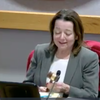Neighbors praise plan for solar facility maintaining farmland
GUILDERLAND — A Nov. 9 hearing on a farm family’s proposal to build a large solar facility got only favorable comments.
“It’s the first meeting I’ve been to in a long time where it’s positive,” said Gerd Beckmann, a Guilderland resident who frequently comments at meetings. “It’s great. I’m in favor,” he said.
He asked two questions: Would the town benefit, and could students from the nearby high school learn from the project.
The answer to both questions was yes.
The town board had accepted the application on July 18 for the facility to be built west of Foundry Road and east of the town’s golf course, maintaining what the town’s planner called a desirable green belt.
Loren Pruskowski, describing himself to the board in July as the son of Diane and Gary Pruskowski and the owner of Ecolegacy Values, said the limited liability company is “holding the development assets on behalf of my family.”
The request now is to rezone about 65 acres in the midst of a 128-acre parcel as a Rural Agricultural District; it is currently zoned as a Residential Overlay District.
The project was then reviewed by the town’s planning board. At the Nov. 9 meeting, Nicholas Schupp, project manager at Renua Energy, told the board there are to be two solar array systems: a ground-mount fixed-tilt system at 2.8 megawatts and a 5-megawatt, single-access tracker system.
“Both of those will come to roughly 33 acres of that 64.85 rezoning plot,” he said.
Schupp said the planning board’s “excellent recommendations” had been followed to change the zone shape. “This time, we encompass … the whole western section of the property to make it more uniform and to give ourselves road frontage,” he said.
Councilwoman Christine Napierski, who chaired the Nov. 9 meeting because Supervisor Peter Barber was out sick with COVID-19, asked if, with the new configuration, the facility would still not be visible from Foundry Road.
“That’s correct,” said Schupp, adding, “You may be able to see the fence line on this corner but that’s the extent of the visual impact.”
The facility will have “a 7-foot high fence per national electric code,” the application says, and also “will include the construction of a 20 foot wide access road, new above and below-ground utility [and]lines, transformer/inverter pads.”
Councilwoman Rosemary Centi asked how long the panels would last. “These panels could operate up to the length of the system’s life cycle, [for] which we usually set a 20- [or] 25-year period,” said Schupp. “From there you could go another 20 years. So it’s more common to see … about 40 [or] 45 years.”
Councilman Jacob Crawford asked about a decommissioning plan to which Schupp responded one had been drafted.
“So what happens when they’re no longer viable?” Centi asked of the panels.
“The recycling business for solar panels has greatly increased over the years,” said Schupp. “It’s becoming a huge industry. They’re not only broken down and recycled for the precious metals that are inside, but they’re also re-fabricated and used in lower income areas. They’re actually also shipped to … Third World countries for second-hand use.”
The efficiency of the panels drops to 80 percent after 20 years, he said, “so the reuse value for solar panels is quite large in the market.”
Napierski asked Pruskowski if he had received pushback from his neighbors over the proposal.
“I think people are happy that we’re not going to subdivide the land for development,” said Pruskowski, “and that they won't actually see the panels.”
Favorable response
The four citizens who spoke at the hearing bore him out.
Ed Downey of 6202 Foundry Road, also speaking on behalf of his wife and son, said, “We’re all in favor of this. We’ve known the family [as] we’ve been there for 40 years. When we moved in, I could look out and see cows across the street. Now, as I understand it, we’re going to see sheep up there.”
“A local friendly pollinator mix will be planted and sheep grazing will be utilized,” says the application.
Downey called the Pruszkowskis “stewards of their property in general.” He went on, “Farming is an industry going out and this is what we need to be able to keep people owning their land and not go into development of major houses.”
Sarah Vanleer of 6301 Foundry Road said she, too, had lived on Foundry for 25 years and also recalled seeing cows graze on the Pruskowski land.
“I’m delighted they’re doing this ….,” she said of the solar project. “I think this is a great use of the property. We have rooftop solar on our barn. I would like the technology to let us hook into this …. I hope the board will approve the changes that are necessary so that this project can go forward.”
Doug Bauer told the board he’d been paying taxes in Guilderland since 1981. “This is land; it’s been farmed for over 100 years,” he said as his voice thickened. “I get emotional. I grew up on a farm and we have about 500 acres and it’s not dairy cows anymore; it’s baling hay.
“This project seems to be so ideally suited because the wildlife will be, in my opinion, unaffected,” he said, naming deer, rabbits, squirrels — “might even be some porcupine around there.”
He went on to say that farming is a “tough business” and the family should be credited for preserving the land. “I’m in favor of people being able to do what they can with their land, legally.”
He concluded, “I think this project could please all of the people at this time. I’m in favor.”
In answer to Beckmann’s question about using the solar facility to teach students, Councilwoman Amanda Beedle, who works for the Board of Cooperative Educational Services, recommended contacting BOCES.
The Capital Region BOCES has said its students it will help construct and maintain a solar array that Albany County is building near the county’s airport.
Loren Pruskowski said he would be “100-percent behind” using the facility to educate students.
On Beckmann’s other question, Schupp said, “The success of this project depends on local subscribers.”
Pruskowski said the facility, once it was up and running, would supply enough electricity for around 2,000 homes.
“Those electrons stay local,” said Schupp.



